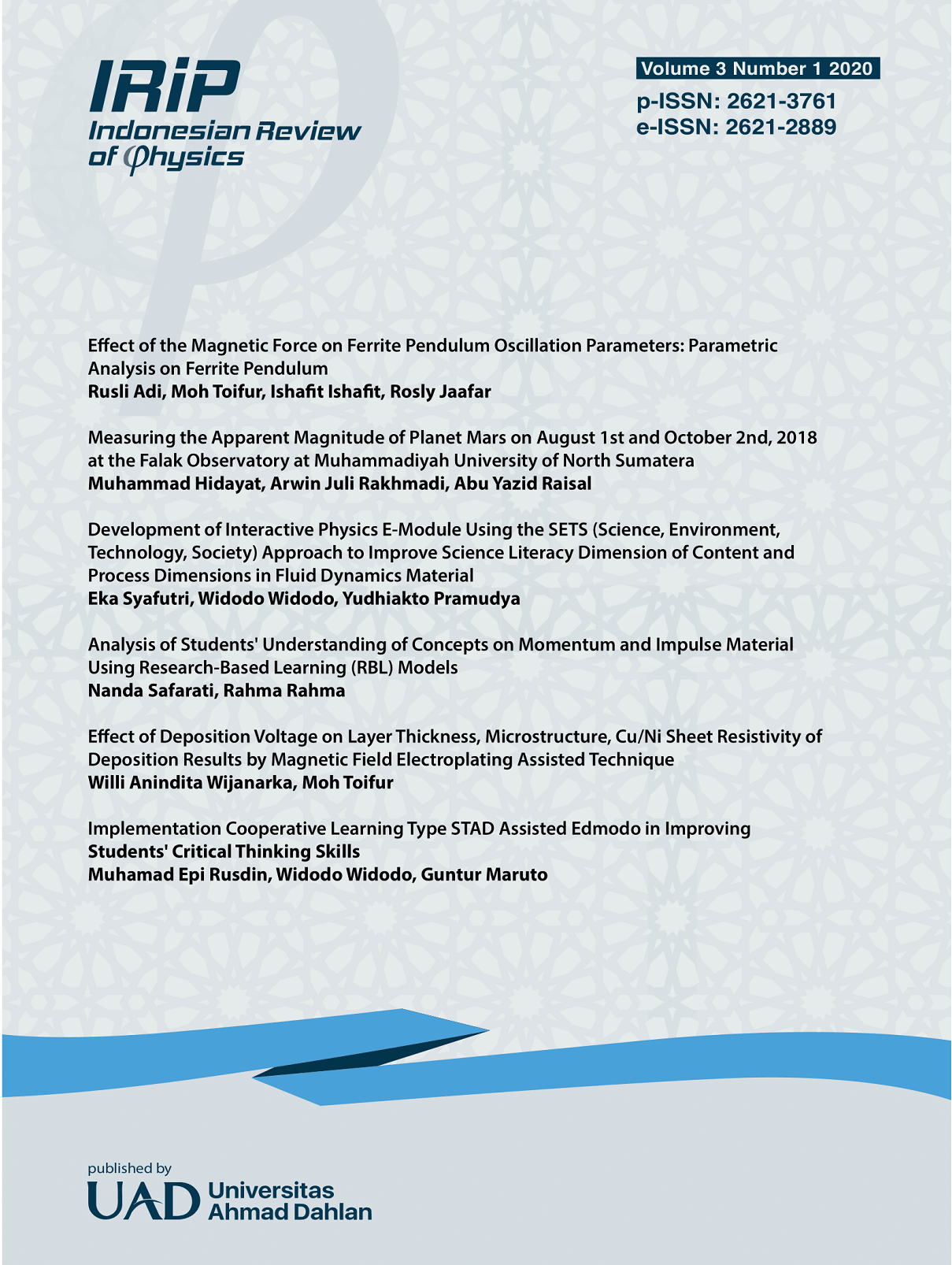Implementation Cooperative Learning Type STAD Assisted Edmodo in Improving Students' Critical Thinking Skills
DOI:
https://doi.org/10.12928/irip.v3i1.1766Keywords:
Cooperative Learning, Critical Thinking Skill, E-learning, Edmodo, LMS, STADAbstract
The STAD cooperative learning model can support active, independent and responsible learning for students. The application of this model is expected to improve students' critical thinking skills. The purpose of this study was to determine the improvement of students' critical thinking skills using Edmodo-assisted learning models. Edmodo was modified to become a teacher tool to expand learning at home. This research is an experimental study using a pretest-posttest control group design involving 39 students of class VIII MTs At-Taqwa Beru, Sikka, East Nusa Tenggara. Based on the results of the study it was found that the Edmodo-assisted STAD type cooperative learning model can improve students' critical thinking skills.References
[2] R. Alfian, E. Wiyanarti, and M. Iqbal, “Increasing of Critical Thinking Students through Cooperative Learning Model TPS Type (Think-Pair-Share) In Social Studies Learning (Classroom Action Research In Class VIII-1/Ibnu Thufail Fitrah Insani II Junior High School),†Int. J. Pedagog. Soc. Stud., vol. 2, no. 2, pp. 46–52, 2017.
[3] P. Eggen and D. Kauchak, Strategi dan Model Pembelajaran: Mengajarkan Konten dan Keterampilan Berpikir, 6th ed. Jakarta: Indeks, 2012.
[4] U. Karuniawati, “Pengembangan Perangkat Pembelajaran Dasar dan Pengukuran Listrik dengan Model Pembelajaran Kooperatif STAD untuk Melatih Keterampilan Berpikir Kritis di SMK Negeri 5 Surabaya,†J. Pendidik. Tek. Elektro, vol. 5, no. 2, pp. 609–615, 2015.
[5] S. Nurazizah, P. Sinaga, and A. Jauhari, “Profil Kemampuan Kognitif dan Keterampilan Berpikir Kritis Siswa SMA pada Materi Usaha dan Energi,†J. Penelit. Pengemb. Pendidik. Fis., vol. 3, no. 2, pp. 197–202, 2017.
[6] G. Carlson and Raphael, Let’s Get Social The Educator’s Guide to Edmodo. Arlington: International Society for technology in education, 2015.
[7] H. Bicen, “The Role of Social Learning Networks in Mobile Assisted Language Learning: Edmodo as A Case Study,†J. Univers. Comput. Sci., vol. 21, no. 10, pp. 1297–1306, 2015.
[8] D. Sulisworo and K. Permprayoon, “What is the Better Social Media for Mathematics Learning? A Case Study at A Rural School in Yogyakarta, Indonesia,†Int. J. Emerg. Math. Educ., vol. 2, no. 1, pp. 39–48, 2018.
[9] A. Hapsari and A. D. Ariana, “Hubungan antara Kesepian dan Kecenderungan Kecanduan Internet pada Remaja,†J. Psikol. Klin. dan Kesehat. Ment., vol. 4, no. 3, pp. 164–171, 2015.
[10] A. Sahin, N. Top, and E. Delen, “Teachers’ First-Year Experience with Chromebook Laptops and Their Attitudes Towards Technology Integration,†Technol. Knowledge, Learn., vol. 21, no. 3, pp. 361–378, 2016.
[11] D. H. Schunk, Learning Theories An Educational Perspective. Boston: Allyn & Bacon, 2012.
[12] W. Winkel, Psikolog Pengajaran. Jakarta: Gramedia, 1989.
[13] R. M. Gagné and K. Medsker, The Conditions of Learning: Training Applications, 5th ed. Pennsylvania: Harcourt Brace College Pub, 1996.
[14] H. Stachowiak, “Modelle: Konstruktion der Wirklichkeit,†J. Philpapers, vol. 45, no. 2, pp. 226–226, 1989.
[15] D. Cross, G. Taasoobshirazi, S. Hendricks, and D. T. Hickey, “Argumentation: A Strategy for Improving Achievement and Revealing Scientific Identities,†Int. J. Sci. Educ., vol. 30, no. 6, pp. 837–861, 2008.
[16] Y. Q. Yusuf, Y. Natsir, and L. Hanum, “A Teacher’s Experience in Teaching with Student Teams-Achievement Division (STAD) Technique,†Int. J. Instr., vol. 8, no. 2, pp. 99–112, 2015.
[17] C. Wankel, Educating Educators with Social Media. United Kingdom: Emerald Group Publishing Limited, 2011.
[18] R. S. Putra, “Penerapan Metode Diskusi Tipe Think Pair Share (TPS) untuk Meningkatkan Keterampilan Berpikir Kritis Siswa dalam Pembelajaran IPS,†Int. J. Pedagog. Soc. Stud., vol. 1, no. 1, pp. 119–131, 2016.
[19] R. H. Ennis, “Critical Thinking: A Streamlined Conception,†Teach. Philos., vol. 14, no. 1, pp. 5–24, 1991.
[20] A. N. Harahap and I. Harahap, “Penerapan Model Pembelajaran Kooperatif Tipe STAD Untuk Meningkatkan Kemampuan Berpikir Kritis Siswa,†PeTeKa (Jurnal Penelit. Tindakan Kelas dan Pengemb. Pembelajaran), vol. 2, no. 2, pp. 45–51, 2019.
[21] C. Kustandi, “Efektivitas E-Learning Berbasis Edmondo dan Schoology Terhadap Kemampuan Berfikir Kritis Mahasiwa Program Studi Teknologi Pendidikan FIP UNJ pada Mata Kuliah Profesi Pendidikan,†J. Educ., vol. 2, no. 1, pp. 1–9, 2017.
Downloads
Published
Issue
Section
License
Authors who publish in IRiP agree to the following terms: Authors retain copyright and grant the IRiP right of first publication with the work simultaneously licensed under a Creative Commons Attribution License (CC BY-SA 4.0) that allows others to share (copy and redistribute the material in any medium or format) and adapt (remix, transform, and build upon the material) the work for any purpose, even commercially with an acknowledgment of the work's authorship and initial publication in IRiP. Authors are able to enter into separate, additional contractual arrangements for the non-exclusive distribution of the journal's published version of the work (e.g., post it to an institutional repository or publish it in a book), with an acknowledgment of its initial publication in IRiP. Authors are permitted and encouraged to post their work online (e.g., in institutional repositories or on their website) prior to and during the submission process, as it can lead to productive exchanges, as well as earlier and greater citation of published work (See The Effect of Open Access).















